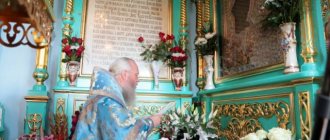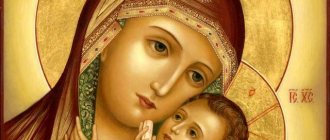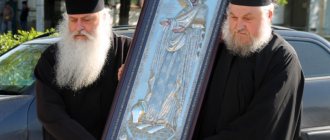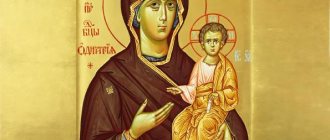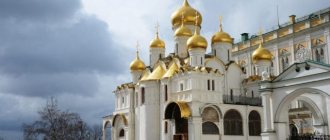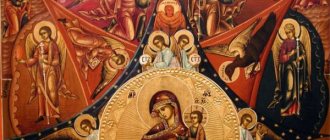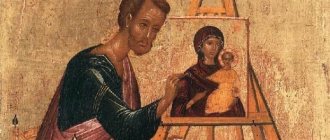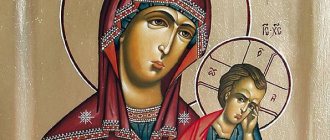Other lists of Cypriot icons
The Cyprus Icon of the Mother of God has other lists.
By the way, they may differ in their spelling, but they will all have the same name. For example, there are lists where the Mother of God does not sit on the throne, but on the sides are Peter of Athos and Onuphrius the Great. In some images the Child holds a scepter in his hands. Another version of the image, also common, is where the Mother of God sits on a throne and the Child is in her arms. There are angels with palm branches around. So, one of the lists is located in Nizhny Novgorod and became famous for many miracles. In this icon, the Mother of God is depicted sitting on a throne, wearing a crown on her head. The Baby sits in his arms, blessing with his right hand. His head is uncovered.
Another list is located in Moscow, in Golutvin, in the Church of St. Nicholas. And the last, quite famous similar image can also be found in Moscow, in the Assumption Cathedral. It depicts the Virgin Mary and Child, with an orb below.
In addition, some ancient copies of the icon can be found in Russian museums, which are kept there as the greatest shrines.
Real examples of help
There are a great many examples of icon help. They date back to the beginning of the 11th century, from the time of the migration of Kikkokista to Cyprus. After prayers in front of the shrine, rains regularly began during droughts. In 1668, there was an unprecedented invasion of locusts on the island. Crops suffered. People prayed, and the Mother of God sent birds to destroy the pests.
Many women who regularly prayed to Kikkokista managed to be cured of infertility and became pregnant. The blind received their sight, the dumb gained the gift of speech. The power of the icon is truly great. You need to approach it with the greatest respect and deep faith in your heart.
How to pray in front of an icon
Orthodox Christians treat the Mother of God with special reverence. During prayer, it is strictly forbidden to look under the veil that hides the face of the Holy Virgin. However, you can look at the image depicted on the bedspread. For every request that a person makes to the Mother of God, there is a special prayer compiled by holy people. It allows you to tune your soul and mind in the right way. If a person does not know the words of the prayer, belongs to another religion or is dumb, then he can turn to the Holy Virgin in his own words or mentally. The words of prayer must be pronounced with reverence. The mind should be calm and devoid of emotions. The request made in front of the icon should not contain conditions to the Blessed Virgin.
It is important that the prayer is not read “for show.” You need to believe that this is a living dialogue with the Most Gracious Mother of God and then she will answer and show a miracle to the one praying
What can you ask for?
Most often, people turn to the icon of Our Lady of Mercy with a prayer for healing from illnesses for themselves and their loved ones. Women ask for the gift of offspring and peace in the family. Our Lady helps with drought and epidemics. Sincere prayer works real miracles.
About rain in dry times
Drought is a big problem for humanity. It destroys crops and causes famine and disease. During a prayer service for rain, the icon of the Mother of God is taken to the top of the mountain and the veil is opened. The face of the Blessed Virgin is turned to heaven.
Helps in conceiving a baby and curing infertility
It often happens that spouses passionately want, but cannot conceive a child. Modern medicine also turns out to be helpless. After countless attempts, people often turn to faith. The image of the Mother of God is a symbol of boundless maternal love and harmony with the child. It is she who often turns to women to get rid of infertility.
You need to pray for conceiving a child correctly. Thoughts and soul must be pure, devoid of sinful habits and passions.
About getting rid of deafness and muteness, headaches, bleeding
At all times, people turned to the icon for help in healing from illnesses. Prayer is a special form of addressing the saints. However, those who cannot resort to the words of prayer due to their illness - deafness or dumbness - can turn to the face of the Most Holy One with their hearts. It also helps soothe headaches and stop bleeding. You can pray to the Most Gracious Mother of God both in church and at home.
About stopping natural disasters
During natural disasters, special prayer rituals are performed. Believers turn to the Mother of God all together, which greatly increases the power of prayer. Often, sacred rites during natural disasters include fasting and repentance of believers. There was also a procession with the icon through the affected areas.
About improving family relationships and ending quarrels
In Orthodoxy, family and family relationships are of great importance. The family hearth is a “small temple”. To improve relationships in the family, you need to regularly turn to the Mother of God as a Gracious patroness. After a quarrel, a prayer service can help you realize that you were wrong and make the right decision. Turning to the image even helps avoid divorce.
About ending the lack of money
You can also turn to the icon of the Blessed Virgin in case of a difficult financial situation. If a person works honestly, but cannot get out of debts and a difficult situation, prayer before the “Merciful One” will help him.
About permission from adversity
It happens that there comes a dark streak in life. In this case, you also need to turn to faith. The Mother of God can protect from negativity, sorrow and sadness.
About salvation from epidemics
During the epidemic, the inhabitants of the island often turned to the clergy with a request to bring the miraculous icon to the village. People believed in the great power of the shrine. The mere presence of an icon in the village could stop all troubles.
Mother of God Igorevskaya embroidered with beads
The Mother of God Igorevskaya is depicted on an icon of ancient Greek writing. This is a smaller shoulder-length version of another famous image - the Mother of God of Vladimir. In the process of creation, the icon painter followed the ancient tradition and created a smaller version of the image of the revered saint.
“Tenderness” was used as the iconographic style. At first glance, it is noticeable that the Mother of God rested her right cheek on the left cheek of the Child Christ. There is a complete lack of distance between them, which reflects their boundless love.
Through such an image, the sacrifice of Christ the Savior on the cross is transformed, showing what happened as an immeasurable and highest manifestation of God’s love for all people.
Beaded Igor Icon of the Mother of God
Materials used in the embroidery of the icon of the Mother of God of Igor: fabric - metallized satin, faces painted in oil on thin canvas, beads, rhinestones, truntal, gimp, pearls, garnet, coral, malachite, amber, citrine.
Until the beginning of the 20th century, the image of the Igor’s Mother of God remained in the Assumption Cathedral of the Kiev Pechersk Lavra. There he was in the altar located above the altar in the chapel of the first martyr Stephen. By the way, the two earliest copies from the shrine were made in the second half of the 16th century. Both are kept in the State Tretyakov Gallery.
They were made in Moscow and their appearance dates back to the time of Metropolitan Macarius, namely 1542-1563. It was the appearance at this time that ensured such an exact repetition of not only the sizes, but also the iconography used.
The Igorevskaya Icon of the Mother of God appeared due to the sad death of the martyr Igor Olegovich, also known as the Holy Blessed Prince Igor of Chernigov. During his life, two groups of princes fought for the throne of Kiev at once - the Olegovichs and the Mstislavovichs.
Igor's brother, Vsevolod, who literally wrested rule from the hands of his opponents, was unable to fully strengthen the power of Kyiv when he was killed. After this, the entire burden fell on the shoulders of the future saint. At the moment of ascending the throne, the ceremony of kissing the cross took place, which was supposed to emphasize the loyalty of the people of Kyiv to their ruler.
Despite the fact that the ascension to the throne took place according to all the rules, Igor’s supporters immediately sent a messenger to the Mstislavichs, calling enemy troops to the walls of the city. Just two weeks later, a decisive battle took place, which determined the future fate of the Holy Blessed Prince Igor of Chernigov.
Despite the fact that the superiority of forces was not on the side of the ruler of Kyiv, at the decisive moment of the battle the troops loyal to him went over to the enemy’s side. Such a betrayal completely turned the tide of the battle, providing the Mstislavichs with a guaranteed victory.
Captured Igor was put in the log. It was a kind of prison, which was a cold wooden frame with no windows or doors. During the period that the former prince spent inside his prison, he managed to become seriously ill.
The enemies, believing in the imminent death of their captive, cut him out of the woodwork. The Mstislavichs, despite their hostility towards the Olegovichs, allowed the martyr to take on the monastic rank before his death. The newly tonsured George, despite all the forecasts, recovered, after which he accepted the schema, taking the name Ignatius.
After this, the former prince of Kiev indulged in Ionic exploits. He spent time crying over his sins, praying for redemption. Meanwhile, his half-blood relatives joined the fight for the lost throne.
Most likely, it was these events that caused the imminent death of Ignatius. The troops of Svyatoslav Olegovich were already approaching the city when the people of Kiev, who harbored hatred for all Olegovichs, burst into the monastery. According to history, the monk prince was not only killed, but his cold body was dragged through the streets all day.
On that day, Ignatius, in the last hours of his life, prayed before the cell icon of the Mother of God of Igor. It is for this reason that she later received the name Mother of God of Igor and began to be revered as miraculous, helping people exposed to sorrows and persecution.
Disappearance of the Igor Icon of the Mother of God
The modern history of the image of the Igor's Mother of God is much more vague. Until the twentieth century, it was kept in the Assumption Cathedral of the Kiev-Pechersk Lavra. But during the Patriotic War, the entire cathedral was destroyed, and the image of the Mother of God Igorevskaya disappeared without a trace.
Although, many historians are inclined to believe that her disappearance occurred earlier, during the establishment of Soviet power and the fight against religion. In any case, only reproductions taken in the 1500s and stored in Russia have survived to this day.
We advise you to study Prayers to calm the soul and heart
Story
The story is amazing and mysterious. We first learn about him from the story “The Tale of Three Icons Written by St. Luke, where each of them is located, and the icon of the Mother of God, called Kykkos, which is located in Cyprus” by the 125-year-old hieromonk Gregory, resident of the Kykkos monastery. Date of creation: 1422.
In the Orthodox capital
The narrative begins with the creation by the Apostle Luke, guided by the Archangel Gabriel, of three iconographic images of the Mother of God, blessed by the Mother of God Herself. One of them - “Eleusa” (translated from Greek - “Merciful”) - later began to be called Kykkos.
After a while, the apostle takes his icon paintings to Egypt. Further, “The Legend..” has some plot inconsistencies. Thus, in the introduction, the author says that a few years later “Eleusa” was sent by the “pious kings” to Athens. However, in the main part of the story, Hieromonk Gregory sets out another version: due to the persecution of Christians, the icon of the Mother of God was sent to Constantinople in 980.
During the sea voyage, the ship was captured by the Saracens, but then freed by Constantinople sailors. They delivered the icon to Constantinople (the capital of Byzantium), where it was placed in the royal palace.
Transfer to the monastery on the island. Cyprus
At the beginning of the 12th century, under the Byzantine Emperor Alexios I Komnenos, the image of the Mother of God was transferred to the island of Cyprus. This was the will of the Queen of Heaven Herself.
One day, the Byzantine commander, ruler of Cyprus, Manuel Voutomitis, was hunting in the Troodos Mountains and lost his way. Having met the hermit monk Saint Isaiah and not receiving an answer from him about the way to Lefkosia (now Nicosia is the capital of the island), Manuel angrily beats the elder, and soon after that he becomes seriously ill.
Realizing that this is how he is punished for his sinful act, Manuel tearfully appeals to God with a request to heal him and grant him the opportunity to ask for forgiveness from the monk who was undeservedly offended by him.
At this time, the Mother of God Herself came to the monk Isaiah in a dream, telling about the sincere repentance of the Cypriot ruler and commanded that, as penance, he bring Her icon from Constantinople to the island.
In the Kykkos Monastery on Mount Kykkos, Fr. Cyprus
Soon after the miraculous healing, Manuel Vutomitis is summoned to the emperor, but he cannot find the right moment to voice his request. At this time, the only beloved daughter of Emperor Alexei I became seriously ill. The best Byzantine doctors were powerless. Realizing that this is the right time to fulfill his promise, he tells his inconsolable father about his healing, about the request of a Cypriot monk to transfer the icon to the island. As soon as the autocrat gave his consent, the princess was immediately healed.
But for delaying the fulfillment of his vow, he suffered the same illness as his daughter and the ruler Manuel. Repentant, the Byzantine ruler ordered the best Constantinople painter to make a copy of the beautiful face and then send it to Cyprus.
But the Mother of God appeared in a dream and strictly commanded him: “Leave your icon here, and immediately send Mine to the island to the monk Isaiah, for this is what pleases me.”
Another version says that Elder Isaiah arrived in Constantinople for the icon. The cunning emperor suggested that the monk choose between two icons and the genuine one. So the next day Rev. Isaiah made the right choice. Since then, the bee has become a kind of “coat of arms” of the monastery as an ancient symbol of hard work, purity, and monastic service to God.
After these events, the king sent the honest image on his ship, accompanied by his retinue, to the island to the Venerable. Isaiah. The Cypriot ruler Manuel specially allocated money for the construction of a temple in the name of the Most Holy Theotokos and ordered him to help in everything.
The elder built a temple on Mount Kykkos, where the holy image was placed. Ruler Manuel granted three settlements and over time, an Imperial monastery appeared near the temple, since it was built at the expense of Alexei I. Today it is the Kykkos stauropegic monastery.
Miracles
As soon as the icon was transferred to the island of Cyprus, miracles immediately began to occur from it. The chronicle of the Kykkos monastery tells about the fourfold salvation of the monastery from fire, miraculous healings, the gift of long-awaited children, the sending of rain in dry, lean years, and the salvation of the monastery from an invasion of locusts.
One monk, mute from birth, standing by the icon, spoke. Another dying monk suddenly became healthy. The pagan, who swung at the holy image, immediately lost his hand. As a reminder of this, an iron hand was hung next to the icon.
Description and history of origin
According to legend, Kikkokista was written during the life of the Holy Virgin. Apostle Luke, under the guidance of Archangel Gabriel, painted three portraits of the Virgin Mary. One of them is “Eleus” (“Merciful”). Upon completion of the work, the saint showed the icon to the Most Holy One and she blessed it, endowing it with amazing miraculous power. The shrine received its name from Mount Kykkos, located on the island of Cyprus.
In the icon, the Mother of God holds little Jesus in her left hand, and touches Christ’s head with her cheek. What makes this picture unusual, from an iconographic point of view, is the baby’s lively and dynamic pose. His legs and arms are bent, his torso is turned frontally, and his legs are turned to the left. It's like he's playing in his mother's arms.
In the Orthodox capital
The relic did not reach the island immediately. Initially, the apostle took the icon to Egypt, where it remained until the 8th century. This period was characterized by the development of iconoclasm, which lasted until the beginning of the 9th century. To save the shrine from destruction, it was sent from Egypt to Byzantium. Along the way, the ship was captured by Arab pirates. The icon did not interest them and was consigned to oblivion. Some time later, around 980, the pirate ship was attacked by the Greeks. By that time, iconoclasm in Byzantium was over, and the image went to Constantinople.
Transfer to Cyprus
The shrine was moved to the island at the beginning of the 11th century, during the reign of Emperor Alexei Komnenos. In a dream, the Mother of God herself appeared before him and ordered him to send the icon to Cyprus. At the same time, a vision appeared to the hermit Isaiah, who lived on Mount Kykkos. In it he saw that a miraculous icon depicting the Blessed Virgin with a baby in her arms would come to the island. The elder turned to the ruler of the island, and he turned to Emperor Alexei, to deliver the shrine to Cyprus.
We advise you to study Prayer to St. Nicholas the Wonderworker for help with money
The Kykkos Monastery was built especially for the Gracious Icon, where it remains today.
Miracles
The Kykkos icon is rightfully considered miraculous. Pilgrims from all over the world come to see it every year. The Merciful Mother of God showed her power upon her arrival in Cyprus. When it was solemnly carried around the island, not only people, but also plants bowed down. Even now, on the way to the monastery, you can see bent trees. Legends about true miracles performed by the Merciful Mother of God have survived to this day:
- One monk was thirsty and turned to the Holy Virgin. He heard a voice that told him to hit the stone. The monk fulfilled the command, and water poured out of the stone. It was a life-giving source, through the waters of which many found healing from their ailments.
- The healing power of the icon is great: the mute from childhood acquired the gift of speech, the dying came to life, the sick recovered.
- During all major fires, the icon remained unharmed.
- After the fires, the clergy saw a service being held in the empty temple, and the Virgin in shining clothes walking around.
- During the restoration of the monastery after a fire, the roof collapsed on the workers. The Mother of God showed her mercy here too; no one was hurt.
Kikkokista is capable of not only giving her mercy, but also punishing for disrespectful attitude:
- One unbeliever decided to hit the icon and his hand withered. In memory of this miracle, an iron hand was hung to the icon so that it would serve as a reminder to everyone that the power of the Holy Virgin is truly great.
- When the Turkish governor extorted money from the monastery, the clergy hid the shrine and began to pray. And an unprecedented downpour began. And it lasted three days. The thunderstorm and lightning frightened the Turks so much that they no longer came to the monastery.
The icon of the Mother of God gives her mercy to everyone who turns their prayers to her sincerely and with faith in the heart.
The Mystery of the Kykkos Icon
The Cypriot icon of the Mother of God is shrouded in mystery. It is decorated with a frame and is hidden from the view of visitors under a velvet embroidered blanket. Only the lower part of the salary remained uncovered. Those who dared to look under the veil were punished by the Mother of God. There are several theories explaining the reason for this mystery:
- order of Emperor Alexei;
- incredibly strong energy of the shrine;
- age.
The Kykkos Mother of God is one of a kind. The faces of other icons of the Mother of God and the Child are open. Only once a year does the icon leave the monastery. The priests take her to the top of the mountain and pray for rain and harvest. But even then no one dares to raise their eyes to the holy faces.
Meaning in Orthodoxy
January 8 is the day of celebration in honor of the Kykkos Icon of the Mother of God. On this day, a service is held and an akathist to the Gracious Icon is read. This unique shrine is revered to this day. Pilgrims from all over the world come to Cyprus to pray to the sacred image of the Mother of God. Not only Orthodox Christians come to the Merciful Mother of God. Representatives of other religions also turn to her in the hope of a miracle. To those whose thoughts are pure and whose faith is strong, the Mother of God shows her mercy.
Many poems and songs are dedicated to the great icon. They were published and sold in huge numbers. A large number of lists have been written from it at different times and in different countries.
The image of the All-Merciful Mother of God on Kikkokista is a symbol of the tender love of mother and son, God’s love for people and a reminder of the great sacrifice made for them.
Description
The image belongs to the category “Eleus”. The faces of the saints are tilted to the left. The Virgin Mary is dressed in red maforium. The God-Infant holds the Mother's robe by the edge with his right hand. The image contains an image of a Greek scroll. It is located in the left hands of Jesus and Mary.
The icon of the Mother of God the Merciful is marked by a characteristic feature: the image seems to be covered with a veil. You can see this feature of Our Lady of Kykkos in detail in the photo.
From the top left to the bottom right, the image becomes blurry. The blurry area in the photo hides the faces of the Mother of God and the Infant God himself. The Blessed Virgin and her Son are poorly distinguishable until the middle part.
Due to the veil, worshipers are not able to see the faces of the saints. But no one is trying to resist this. In addition to the shroud, the image of the Mother of God is covered from prying eyes with a veil made of red velvet.
The velvet bedspread became the source of a number of legends and speculations:
- The shrine began to be covered by the will of Emperor Alexius Komnenos.
- The energy and force of the image’s influence on a parishioner can deprive a person of sight and make a person go blind.
- The velvet fabric is used as a tribute to the age of the icon.
As punishment for his act, the clergyman became blind. To atone for his sin, Gerasim of Alexandria prayed day and night, calling on the Almighty for forgiveness.
Only once a year the faces of the saints are not hidden from the eyes of parishioners. During the prayer service, the image is on the Tron Mountain without a velvet cover. Despite the openness of the shrine, worshipers are prohibited from looking at it.
Appearance of the Icon of the Mother of God “Life-Giving Spring”
In the 5th century in Constantinople, near the so-called “Golden Gate”, there was a grove dedicated to the Blessed Virgin Mary. There was a spring in the grove, glorified for miracles for a long time. Gradually, this place was overgrown with bushes, and the water was covered with mud.
Icon of the Mother of God “Life-Giving Spring”
One day the warrior Leo Marcellus, the future emperor, met in this place a blind man, a helpless traveler who had lost his way. The lion helped him out onto the path and sit down in the shade to rest, while he himself went in search of water to refresh the blind man. Suddenly he heard a voice: “Lion! Don’t look far for water, it’s close here.” Surprised by the mysterious voice, he began to look for water, but did not find it. When he stopped in sadness and thoughtfulness, the same voice was heard a second time: “King Lion! Go under the shade of this grove, draw the water that you find there, and give it to the thirsty person, and put the mud that you find in the source on his eyes. Then you will know who I am, who sanctifies this place. I will help you soon build a temple here in My name, and everyone who comes here with faith and calls on My name will receive the fulfillment of their prayers and complete healing from ailments.” When Leo fulfilled everything he was commanded, the blind man immediately received his sight and, without a guide, went to Constantinople, glorifying the Mother of God. This miracle happened under Emperor Marcian (391-457).
Emperor Marcian was succeeded by Leo Marcellus (457-473). He remembered the appearance and prediction of the Mother of God, ordered the source to be cleaned and enclosed in a stone circle, over which a temple was built in honor of the Most Holy Theotokos. Emperor Leo called this spring the “Life-Giving Spring,” since the miraculous grace of the Mother of God was manifested in it.
Emperor Justinian the Great (527-565) was a man deeply committed to the Orthodox faith. He suffered from water sickness for a long time. One day at midnight he heard a voice: “You cannot regain your health unless you drink from My fountain.” The king did not know what source the voice was talking about, and became despondent. Then the Mother of God appeared to him in the afternoon and said: “Get up, king, go to My source, drink water from it and you will be healthy as before.” The patient fulfilled the will of the Lady and soon recovered. The grateful emperor erected a new magnificent temple near the temple built by Leo, at which a populous monastery was subsequently created.
We advise you to study Merry Christmas to the Blessed Virgin Mary
In the 15th century, the famous temple of the “Life-Giving Spring” was destroyed by Muslims. A Turkish guard was assigned to the ruins of the temple, who did not allow anyone to approach this place. Gradually, the severity of the ban softened, and Christians built a small church there. But it was also destroyed in 1821, and the source was filled up. The Christians again cleared the ruins, opened the spring and continued to draw water from it. Subsequently, in one window, among the rubble, a sheet half-rotten from time and dampness was found with a record of ten miracles from the Life-Giving Spring that occurred from 1824 to 1829. Under Sultan Mahmud, the Orthodox received some freedom in performing divine services. They used it to build a temple over the Life-Giving Spring for the third time. In 1835, with great triumph, Patriarch Constantine, concelebrated by 20 bishops and with a large number of pilgrims, consecrated the temple; A hospital and almshouse were set up at the temple.
One Thessalian from his youth had a strong desire to visit the Life-Giving Spring. Finally, he managed to set off, but on the way he became seriously ill. Feeling the approach of death, the Thessalian took word from his companions that they would not bury him, but would take his body to the Life-Giving Spring, there they poured three vessels of life-giving water on it and only after that buried it. His wish was fulfilled, and life returned to the Thessalian at the Life-Giving Spring. He accepted monasticism and spent the last days of his life in piety.
The appearance of the Mother of God to Leo Marcellus took place on April 4, 450. On this day, as well as every year on Friday of Bright Week, the Orthodox Church celebrates the renovation of the Constantinople temple in honor of the Life-Giving Spring. According to the charter, on this day the rite of blessing of water is performed with an Easter religious procession.
The Most Holy Theotokos with the Infant God is depicted in the icon above a large stone bowl standing in a reservoir. Near a reservoir filled with life-giving water, those suffering from bodily ailments, passions and mental infirmities are depicted. They all drink this life-giving water and receive various healings.
Icon of the Mother of God “Ilinsko-Chernigovskaya”.
Day of celebration: April 29 (April 16, old style), icon of the Mother of God “ILINSK-CHERNIGOV” - pray for healing from paralysis, smallpox, leg disease, attacks by dark forces, from sudden death.
Most Pure Lady Theotokos, / the hope of all Christians, / without any other hope, are not the Imams except You, / My All-Immaculate Lady, Lady Theotokos, / Mother of Christ my God. / Therefore, have mercy and deliver me from all my evils / and implore Your Merciful Son and my God, / may He have mercy on my accursed soul, / and may He deliver me from eternal torment, and grant me His Kingdom.
Prayer to the Most Holy Theotokos in front of Her icon, called “Chernigov” (Ilyinskaya).
Oh, Most Holy Lady, my Lady Theotokos, heavenly Queen, save and have mercy on me, Thy sinful servant, from vain slander, from all misfortune and misfortune and sudden death. Have mercy on me in the hours of the day, and in the morning, and in the evening, and at all times preserve me: protect me standing and sitting, and provide for me walking on every path, and provide for me sleeping in the night hours, cover and intercede. Protect me, Lady Theotokos, from all my enemies, visible and invisible, and from every evil situation. In every place and at every time, be the Mother of God, an insurmountable wall and a strong intercession. Oh, Most Holy Lady Virgin Mary, accept my unworthy prayer and save me from a vain death, and grant me repentance before the end. Most Holy Theotokos, save us. You appear to me as the guardian of all life, Most Pure One! Deliver me from demons at the hour of death! May you rest in peace even after death! We take refuge under Your mercy, Virgin Mother of God, do not despise our prayers in sorrows, but deliver us from troubles, O pure and blessed one. Most Holy Theotokos, save us. Amen.
Elias-Chernigov Icon of the Mother of God.
The icon became famous in 1662 in the Trinity Elias Monastery near Chernigov. Through prayers to the Mother of God in front of Her miraculous image, the monastery was saved from the Tatars who attacked the monastery. From April 16 to April 24, almost all residents of Chernigov witnessed how tears flowed from this icon. Soon after this, the Tatars raided Chernigov and ravaged its surroundings. The monks of the Ilinsky Monastery, having prayed to the Heavenly Intercessor in front of Her icon, took refuge in a cave. No matter how hard the Tatars who broke into the monastery tried to take possession of the jewelry adorning the miraculous icon, an invisible force did not allow them to touch the shrine. The same invisible force repelled the Tatars every time they tried to enter the cave where the monks hid. Frightened by the incomprehensible phenomenon, the Tatars fled. A miraculous copy (copy) of the Elias-Chernigov icon, famous in the Gethsemane monastery. near the Trinity-Sergius Lavra., began to be called the Gethsemane Chernigov Icon of the Blessed Virgin Mary..
Currently, the original Elias-Chernigov icon of the Blessed Virgin Mary is located together with the Yelets-Chernigov icon. in the Chernigov Assumption Yelets Monastery, revived in 1992.
Lyrics
On the day of remembrance of the Kykkos Icon of the Mother of God, on January 8 and November 25, a festive service is performed. The main texts of any worship service are prayers and chants.
Prayer
During the service, believers read a common prayer. Common prayer has great power and meaning.
“O Most Holy and Most Blessed Mother of our Lord, God and Savior Jesus Christ, Merciful Mother of God and Ever-Virgin Mary! Falling before Your holy and miraculous icon, we humbly pray to You, our Good and Merciful Intercessor: listen to the voice of our sinful prayers, do not despise the sighs from the soul, seeing the sorrows and misfortunes that have befallen us, and like a truly loving Mother, striving to help us helpless, sad, Those who have fallen into many and grave sins and continually anger our Lord and Creator, pray to Him, our Representative, not to destroy us with our iniquities, but to show us His philanthropic mercy. Ask us, O Lady, from His goodness, bodily health and spiritual salvation, a pious and peaceful life, fruitfulness of the earth, goodness of the air, well-timed rains and a blessing from above for all our good deeds and undertakings, and as of old you mercifully looked upon the humble praise of the novice of Athonite. , who sang a song of praise to You before Your most pure icon, and You sent Archangel Gabriel to him to teach him to sing the heavenly song, with which the angels of the mountain glorify You, graciously accept our prayer now fervently offered to You, and bring it to Your Son and God, may He be merciful He will be a sinner for us, and He will add His mercy to all who honor Thee and worship Thy holy image with faith. O All-Merciful Queen, All-merciful Mother of God, stretch out Your God-bearing hands to Him, in His image, as if You were carrying a baby, and beg Him to save us all and deliver us from eternal destruction. Show us, O Lady, Your generosity: heal the sick, comfort the afflicted, help the needy, make us all prosperous to bear the yoke of Christ in patience and humility, grant us a pious end to this earthly life, receive a Christian shameless death, and inherit the Heavenly Kingdom, through Your maternal intercession to To Christ our God, who was born of You, and to Him with His Originless Father and the Most Holy Spirit, befits all glory, honor and worship, now and ever, and unto the ages of ages. Amen".
Troparion
The troparion is sung at the beginning and end of the service. It reveals the essence of this holiday. His words are:
“Let us pray, people, with boldness to the Merciful Queen Theotokos, and tenderly cry to Her: send down, O Lady, Thy rich mercies, preserving Thy sinful servants in health and prosperity. Heal the sick, comfort the sorrowing and help the needy. And grant us, O Most Merciful One, to end this earthly life piously, to receive a Christian shameless death and to inherit the Heavenly Kingdom. Deliver our city from every evil situation, protecting it with Your merciful intercession. Grant peace and seek salvation for our souls.”
Kontakion
After the troparion, kontakion is performed. It more fully reveals the meaning of the event being sung and reflects its other side:
Kontakion 1
“Chosen from all generations, the Virgin Mother of the Lord God Most High, in the radiant glory of heaven, above the Cherubim and Seraphim, to the Lady Queen, incline Your mercy towards us sinners, quench the sadness of our hearts; spread Your honorable cover over us, visit our sorrowful life, there is no other help for the Imams, there is no other hope for the Imams except You, the Mother of our race. In fear and trembling before the greatness of Thy mercy, on bended knee, we ask Thy intercession before Thy immortal Son, calling with tenderness: Rejoice, Merciful Mother of God, pouring out Thy mercy upon us.”
Kontakion 2
“Seeing You upon the clouds, spreading Your honorable cover, and thereby protecting us, we cry out to God with gratitude: Alleluia.”
Kontakion 3
“The power of the Most High guarded You, when with infant feet You created the ascent of the stairs of the temple of the Lord, and we, sinners, trusting in Your Mother’s mercy, sadly pray: lead us up the ladder of salvation; let us draw near to the throne of the glory of God, calling with gratitude: Alleluia.”
Kontakion 4
“Suffering desperate storms in our hearts, having depended on our lives in sins, we resort to You, Mother of God, and humbly pray: give us strength of spirit, give us meekness and humility, patience and wisdom to endure all our sorrows, so that we may sing to God: Alleluia.”
Kontakion 5
“The godly star appeared to the Magi in heaven, and illuminated the den with a wondrous display, showing the King of glory lying in a manger; and with him His Mother, a pure and holy Virgin, composing songs in Her heart like an angel. O Virgin of meekness and humility, offer up our praise to the Lord: Alleluia.”
Kontakion 6
“The preaching of love, meekness and forgiveness to the world, proclaiming with Christ, Your Son, having endured all the sorrows of earth. She adopted the Apostle John and with him the entire Christian race to her mother's heart. Oh, Ever-Virgin Most Immaculate, give us our heavenly Mother, consolation and maternal warmth to those in need, and with thanksgiving we call to the Lord: Alleluia.”
Kontakion 7
“Desiring to be inseparable with your only begotten Son until death on the cross, you followed the innocent Sufferer to Golgotha and at the foot of the Cross heard the cries of an enraged host, and you suffered in silence. And fill Your very soul with this great sorrow. We, marveling at Your indescribable maternal courage, call: Alleluia.”
Kontakion 8
“The great and glorious mystery of Your ascension, Christ God, revealed to the world and seated at the right hand of God the Father, and to us who live on earth, for the villages of paradise who mourn, send down the Comforter, the Spirit of Truth and indwell us, the Giver of Life, through the prayers of Your Mother, so we call: Alleluia "
Kontakion 9
“Whoever calls on the name of the Lord will be saved, and I will pour out My Spirit on all flesh,” says the Lord. On You, Mother of God, the grace of the Holy Spirit was poured out beyond all measure. You have contained our Creator and Founder. Pour out the mercy of Your Son onto our suffering souls, and cry out with a lightened heart: Alleluia.”
Kontakion 10
“To save the world, the Good Shepherd calls everyone to salvation and draws everyone to himself; love the righteous and have mercy on sinners, save us sinners through the prayers of the Mother of God, let us sing: Alleluia.”
Kontakion 11
“Angelic singing accompanies the righteous departing after death. How will we, sinners, find salvation, how will we appear before the righteous Judge; but in Thee, Mother of God, we tenderly ask those who trust in You: save by Your Motherly intercession our souls who sing: Alleluia.”
Kontakion 12
“You have revealed the grace of Your Son to the world, Ever-Virgin, Most Immaculate, save us sinners who cry for Your mercy: Alleluia.”
Kontakion 13
“Oh, all-sung Mati, oh, Mati, filled with grace. Accept our tearful prayers to You, and at this time, boldly at Your mercy, from the depths of our souls we offer You a song: Alleluia.”
This kontakion is read three times, then ikos 1 and kontakion 1.
Greatness
During the festive service, the glorification of the Mother of God is also sung. The words of magnification are picked up by the choir and all the parishioners of the temple, and they sing until the priest makes his way through the temple.
“We magnify Thee, Most Holy Virgin, and honor Thy holy image, through which we heal our illnesses and raise souls to God.”
